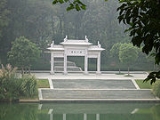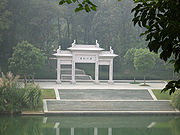
Yu Qian
Encyclopedia

Hangzhou
Hangzhou , formerly transliterated as Hangchow, is the capital and largest city of Zhejiang Province in Eastern China. Governed as a sub-provincial city, and as of 2010, its entire administrative division or prefecture had a registered population of 8.7 million people...
, Zhejiang province), was a Chinese Defence Minister during the Ming dynasty
Ming Dynasty
The Ming Dynasty, also Empire of the Great Ming, was the ruling dynasty of China from 1368 to 1644, following the collapse of the Mongol-led Yuan Dynasty. The Ming, "one of the greatest eras of orderly government and social stability in human history", was the last dynasty in China ruled by ethnic...
.
Biography
He is best known for saving ChinaChina
Chinese civilization may refer to:* China for more general discussion of the country.* Chinese culture* Greater China, the transnational community of ethnic Chinese.* History of China* Sinosphere, the area historically affected by Chinese culture...
when the Zhengtong Emperor
Zhengtong Emperor
Zhu Qizhen was an emperor of the Ming Dynasty. He ruled as the Zhengtong Emperor from 1435 to 1449, and as the Tianshun Emperor from 1457 to 1464....
fought the Mongol
Mongolia
Mongolia is a landlocked country in East and Central Asia. It is bordered by Russia to the north and China to the south, east and west. Although Mongolia does not share a border with Kazakhstan, its western-most point is only from Kazakhstan's eastern tip. Ulan Bator, the capital and largest...
leader Esen Tayisi
Esen Tayisi
Esen taishi was a powerful Oirat Khagan of the Northern Yuan Dynasty in Mongolia in the 15th century. He is best known for capturing the Zhengtong Emperor of the Ming Dynasty in 1450 after the Battle of Tumu Fortress and briefly reuniting the Mongols...
in 1449 and was taken prisoner at the Tumu Crisis
Tumu Crisis
The Tumu Crisis ; also called the Crisis of Tumubao or Battle of Tumu Fortress , was a frontier conflict between the Oirat Mongols and the Chinese Ming Dynasty which led to the capture of the Zhengtong Emperor on September 1, 1449 and the loss of an army of 500,000 men to a much smaller force....
. The Mongol armies came within 80 km of the capital Beijing
Beijing
Beijing , also known as Peking , is the capital of the People's Republic of China and one of the most populous cities in the world, with a population of 19,612,368 as of 2010. The city is the country's political, cultural, and educational center, and home to the headquarters for most of China's...
at which point the Jingtai Emperor
Jingtai Emperor
The Jingtai Emperor was Emperor of China from 1449 to 1457. The second son of the Xuande Emperor, he was selected in 1449 to succeed his older brother, the Zhengtong Emperor, when the latter was captured by Mongols following the Tumu Crisis...
was installed as ruler of China. Yu Qian, as the de-facto Defence Minister, took control of troops, repelling the Mongol
Mongolia
Mongolia is a landlocked country in East and Central Asia. It is bordered by Russia to the north and China to the south, east and west. Although Mongolia does not share a border with Kazakhstan, its western-most point is only from Kazakhstan's eastern tip. Ulan Bator, the capital and largest...
invasion. After the Zhengtong Emperor was released and his plot to regain the throne succeeded, Yu was slandered as a traitor and executed along with many of the highly ranked officials in the Jingtai Emperor
Jingtai Emperor
The Jingtai Emperor was Emperor of China from 1449 to 1457. The second son of the Xuande Emperor, he was selected in 1449 to succeed his older brother, the Zhengtong Emperor, when the latter was captured by Mongols following the Tumu Crisis...
regime , but his rank was restored posthumously. He is considered by many to be a Chinese hero.

